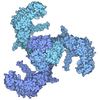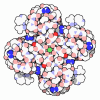+ Open data
Open data
- Basic information
Basic information
| Entry | Database: PDB / ID: 7sk1 | |||||||||
|---|---|---|---|---|---|---|---|---|---|---|
| Title | TWIK1 in MSP1E3D1 Lipid Nanodisc at pH 5.5 | |||||||||
 Components Components | Potassium channel subfamily K member 1 | |||||||||
 Keywords Keywords | TRANSPORT PROTEIN / K+ Channel / pH | |||||||||
| Function / homology |  Function and homology information Function and homology informationTandem of pore domain in a weak inwardly rectifying K+ channels (TWIK) / Phase 4 - resting membrane potential / potassium channel complex / voltage-gated monoatomic ion channel activity involved in regulation of postsynaptic membrane potential / inward rectifier potassium channel complex / ligand-gated channel activity / potassium ion leak channel activity / regulation of resting membrane potential / inward rectifier potassium channel activity / cellular response to acidic pH ...Tandem of pore domain in a weak inwardly rectifying K+ channels (TWIK) / Phase 4 - resting membrane potential / potassium channel complex / voltage-gated monoatomic ion channel activity involved in regulation of postsynaptic membrane potential / inward rectifier potassium channel complex / ligand-gated channel activity / potassium ion leak channel activity / regulation of resting membrane potential / inward rectifier potassium channel activity / cellular response to acidic pH / glutamate secretion / sodium channel activity / potassium channel activity / potassium ion transmembrane transport / sodium ion transmembrane transport / chloride transmembrane transport / synaptic membrane / response to nicotine / brush border membrane / recycling endosome / perikaryon / endosome / apical plasma membrane / protein heterodimerization activity / dendrite / identical protein binding / membrane / plasma membrane Similarity search - Function | |||||||||
| Biological species |  | |||||||||
| Method | ELECTRON MICROSCOPY / single particle reconstruction / cryo EM / Resolution: 3.43 Å | |||||||||
 Authors Authors | Turney, T.S. / Brohawn, S.G. | |||||||||
| Funding support |  United States, 2items United States, 2items
| |||||||||
 Citation Citation |  Journal: Nat Commun / Year: 2022 Journal: Nat Commun / Year: 2022Title: Structural Basis for pH-gating of the K channel TWIK1 at the selectivity filter. Authors: Toby S Turney / Vivian Li / Stephen G Brohawn /  Abstract: TWIK1 (K2P1.1, KCNK1) is a widely expressed pH-gated two-pore domain K channel (K2P) that contributes to cardiac rhythm generation and insulin release from pancreatic beta cells. TWIK1 displays ...TWIK1 (K2P1.1, KCNK1) is a widely expressed pH-gated two-pore domain K channel (K2P) that contributes to cardiac rhythm generation and insulin release from pancreatic beta cells. TWIK1 displays unique properties among K2Ps including low basal activity and inhibition by extracellular protons through incompletely understood mechanisms. Here, we present cryo-EM structures of TWIK1 in lipid nanodiscs at high and low pH that reveal a previously undescribed gating mechanism at the K selectivity filter. At high pH, TWIK1 adopts an open conformation. At low pH, protonation of an extracellular histidine results in a cascade of conformational changes that close the channel by sealing the top of the selectivity filter, displacing the helical cap to block extracellular ion access pathways, and opening gaps for lipid block of the intracellular cavity. These data provide a mechanistic understanding for extracellular pH-gating of TWIK1 and illustrate how diverse mechanisms have evolved to gate the selectivity filter of K channels. #1:  Journal: Biorxiv / Year: 2021 Journal: Biorxiv / Year: 2021Title: Structural Basis for pH-Gating of the K + Channel TWIK1 at the Selectivity Filter Authors: Turney, T.S. / Li, V. / Brohawn, S.G. | |||||||||
| History |
|
- Structure visualization
Structure visualization
| Movie |
 Movie viewer Movie viewer |
|---|---|
| Structure viewer | Molecule:  Molmil Molmil Jmol/JSmol Jmol/JSmol |
- Downloads & links
Downloads & links
- Download
Download
| PDBx/mmCIF format |  7sk1.cif.gz 7sk1.cif.gz | 107.5 KB | Display |  PDBx/mmCIF format PDBx/mmCIF format |
|---|---|---|---|---|
| PDB format |  pdb7sk1.ent.gz pdb7sk1.ent.gz | 80.4 KB | Display |  PDB format PDB format |
| PDBx/mmJSON format |  7sk1.json.gz 7sk1.json.gz | Tree view |  PDBx/mmJSON format PDBx/mmJSON format | |
| Others |  Other downloads Other downloads |
-Validation report
| Summary document |  7sk1_validation.pdf.gz 7sk1_validation.pdf.gz | 1.1 MB | Display |  wwPDB validaton report wwPDB validaton report |
|---|---|---|---|---|
| Full document |  7sk1_full_validation.pdf.gz 7sk1_full_validation.pdf.gz | 1.1 MB | Display | |
| Data in XML |  7sk1_validation.xml.gz 7sk1_validation.xml.gz | 26.8 KB | Display | |
| Data in CIF |  7sk1_validation.cif.gz 7sk1_validation.cif.gz | 38.5 KB | Display | |
| Arichive directory |  https://data.pdbj.org/pub/pdb/validation_reports/sk/7sk1 https://data.pdbj.org/pub/pdb/validation_reports/sk/7sk1 ftp://data.pdbj.org/pub/pdb/validation_reports/sk/7sk1 ftp://data.pdbj.org/pub/pdb/validation_reports/sk/7sk1 | HTTPS FTP |
-Related structure data
| Related structure data |  25169MC  7sk0C M: map data used to model this data C: citing same article ( |
|---|---|
| Similar structure data |
- Links
Links
- Assembly
Assembly
| Deposited unit | 
|
|---|---|
| 1 |
|
- Components
Components
| #1: Protein | Mass: 38265.984 Da / Num. of mol.: 2 Source method: isolated from a genetically manipulated source Source: (gene. exp.)   Komagataella pastoris (fungus) / References: UniProt: Q9Z2T2 Komagataella pastoris (fungus) / References: UniProt: Q9Z2T2#2: Chemical | #3: Chemical | #4: Chemical | Has ligand of interest | Y | Has protein modification | Y | |
|---|
-Experimental details
-Experiment
| Experiment | Method: ELECTRON MICROSCOPY |
|---|---|
| EM experiment | Aggregation state: PARTICLE / 3D reconstruction method: single particle reconstruction |
- Sample preparation
Sample preparation
| Component | Name: TWIK1 in MSPE3D1 Lipid Nanodisc at pH 5.5 / Type: COMPLEX / Entity ID: #1 / Source: RECOMBINANT | ||||||||||||||||||||
|---|---|---|---|---|---|---|---|---|---|---|---|---|---|---|---|---|---|---|---|---|---|
| Source (natural) | Organism:  | ||||||||||||||||||||
| Source (recombinant) | Organism:  Komagataella pastoris (fungus) Komagataella pastoris (fungus) | ||||||||||||||||||||
| Buffer solution | pH: 5.5 | ||||||||||||||||||||
| Buffer component |
| ||||||||||||||||||||
| Specimen | Embedding applied: NO / Shadowing applied: NO / Staining applied: NO / Vitrification applied: YES | ||||||||||||||||||||
| Specimen support | Grid type: Quantifoil R1.2/1.3 | ||||||||||||||||||||
| Vitrification | Instrument: FEI VITROBOT MARK III / Cryogen name: ETHANE / Humidity: 100 % / Chamber temperature: 277 K |
- Electron microscopy imaging
Electron microscopy imaging
| Experimental equipment |  Model: Talos Arctica / Image courtesy: FEI Company |
|---|---|
| Microscopy | Model: FEI TALOS ARCTICA |
| Electron gun | Electron source:  FIELD EMISSION GUN / Accelerating voltage: 200 kV / Illumination mode: FLOOD BEAM FIELD EMISSION GUN / Accelerating voltage: 200 kV / Illumination mode: FLOOD BEAM |
| Electron lens | Mode: BRIGHT FIELD |
| Image recording | Electron dose: 50.3523 e/Å2 / Film or detector model: GATAN K3 (6k x 4k) |
- Processing
Processing
| Software | Name: PHENIX / Version: 1.18.2_3874: / Classification: refinement | ||||||||||||||||||||||||||||||||||||
|---|---|---|---|---|---|---|---|---|---|---|---|---|---|---|---|---|---|---|---|---|---|---|---|---|---|---|---|---|---|---|---|---|---|---|---|---|---|
| EM software |
| ||||||||||||||||||||||||||||||||||||
| CTF correction | Type: PHASE FLIPPING AND AMPLITUDE CORRECTION | ||||||||||||||||||||||||||||||||||||
| 3D reconstruction | Resolution: 3.43 Å / Resolution method: FSC 0.143 CUT-OFF / Num. of particles: 38126 / Symmetry type: POINT | ||||||||||||||||||||||||||||||||||||
| Atomic model building | B value: 143 / Protocol: RIGID BODY FIT / Space: REAL / Target criteria: Correlation coefficient | ||||||||||||||||||||||||||||||||||||
| Atomic model building | PDB-ID: 3UKM Accession code: 3UKM / Source name: PDB / Type: experimental model | ||||||||||||||||||||||||||||||||||||
| Refine LS restraints |
|
 Movie
Movie Controller
Controller











 PDBj
PDBj










